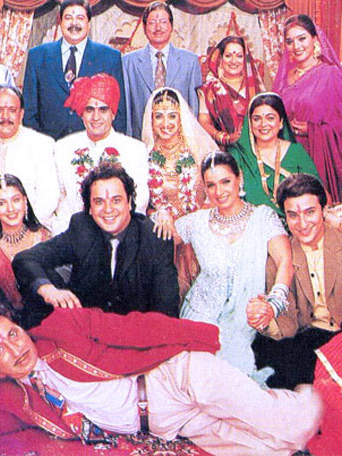The music documentary, Song of Lahore, directed by Sharmeen Obaid-Chinoy and Andy Schocken, is about a group of musicians in Pakistan, the Sachal Ensemble, that take on the music genre of jazz, and go to New York City to perform (Obaid-Chinoy & Schocken, 2015). The Sachal Ensemble’s idea of success, through the post-colonialist ideal, is illustrated through their interviews, interactions with family, and a quest for an ever-lasting legacy.
The benchmark of success, for this band, is manifested through the acknowledgment they receive from the jazz community in New York. After trying to gauge the audience in Pakistan, the Sachal Ensemble is at a disadvantage due to the aftereffects of General Zia Ul-Haq’s Islamization in the late 1970s (Obaid-Chinoy & Schocken, 2015). The Sachal Ensemble manages to eventually play in Pakistan after their debut at Lincoln Center in New York City. From the audience's perspective we can see this as a classic case of westernization; in the sense that the idea of success may be painted as a success only because the ensemble gains attention from western audiences by using western culture within their own music.
Part of this success is credited to the concept of jazz itself, and the Sachal Ensemble’s eagerness to merge this style of music with their own. In its origin, jazz is a symbol of rebellion, and an urgent statement toward freedom; this has also been further articulated within the reading (Saito, 2020). “Jazz was born in and remains a potent symbol of America. Still, jazz goes beyond Americanism. The various routes jazz followed in the process of expanding its popularity outside America obscure its roots, which has resulted in an enriched hybridity of jazz today” (Saito, 2020, p. 9). Although jazz is a symbol of resistance against parts of the American system, for many in Pakistan who witnessed the ensemble’s success, jazz embodied western society, the good and the bad. This convergence in music styles between the Sachal Ensemble and others performing at Lincoln Center, although powerful, in retrospect, reflects post-colonialist ideals set in Pakistan before the ensemble’s existence.
A scholarly source analyzes Pakistan and Bangladesh’s attachment to these ideals that the British had left behind. “What remains problematic is the social character, affiliations, and commitments of the bureaucratic-military oligarchy, or those of different sections of it, vis-a-vis the various social classes in Pakistan and its different regions, including the metropolitan bourgeoisies which have re-appeared, in the plural, after British colonial rule ended” (Alavi, 1972, p. 65). These remnants of British ideals are evident through the story of the Sachal Ensemble composer, Nijat. Throughout the documentary, there are emotionally intimate moments and interviews with Nijat, where he makes it clear that his life’s goal is to carry on this music and make his father proud (Obaid-Chinoy & Schocken, 2015). After traveling to New York and performing there, although their music has been fused with western aspects of jazz, Nijat feels that he has satisfied his father’s dream.
The idea of satisfying his father’s dream by going to the US, has probable cause due to the history of prior musical success in Pakistan. Pakistan’s most famous musical artist, Nusrat Fateh Ali Khan, is looked at as successful, mainly due to the globalization of his music (Shankar, 1999). After almost a decade of performing in Pakistan, Nusrat Fateh Ali achieved this globalization when he was then invited to England to perform in 1985 (Jacoviello, 2011). This same idea of globalization, equaling success, is rooted in Pakistan’s post-colonialist ideals. In this way, many look at the globalized success of Nusrat Fateh Ali as the basis of what success should look like. This idea is reinforced even more when he and the other ensemble members return home to see all the elderly women and men in their families proud. At this point, they are on the front page of the local newspaper, as all their family members look at the ensemble’s photo under the headline wide-eyed. The families of the Sachal Ensemble finally see a legacy being formed in terms of what they have always defined legacy to be.
In a review of the documentary, The National, recounts this scene, along with the ending of the film. “The documentary ends with the group back home, elated to finally have achieved some recognition, and preparing to perform in Lahore for the first time. It’s a fittingly optimistic end to a film that is as much about the power of hope as it is about music” (Kappal, 2016, p. 15). Even though the documentary could have dug deeper into Pakistan’s post-colonialist context, the director’s strength was in instilling hope towards the end. By the end of the film, the Sachal Ensemble performs their first show in Pakistan. As the audience, we finally feel that the ensemble has achieved the recognition that they have always deserved, through their own people, in their own nation.
References
Alavi, H. (1972). The State in Post-Colonial Societies Pakistan and Bangladesh. New Left Review, 0(74), 59. Periodicals Archive Online.
Imran, R. (2016). Towards a theory of ‘Cinema of Accountability’: Critical perspectives on activist film practices. In Activist Documentary Film in Pakistan: The Emergence of a Cinema of Accountability (pp. 40–62). Taylor & Francis Group. https://ebookcentral.proquest.com/lib/northwestern/detail.action?docID=4538785
Jacoviello, S. (2011). Nusrat Fateh Ali Khan: The strange destiny of a singing mystic. When music travels. . . 2011(183), 319–341. https://doi.org/10.1515/semi.2011.016
Kappal, B. (2016, July 13). Song of Lahore documents a Pakistani jazz triumph in the US. The National. https://www.thenationalnews.com/arts/song-of-lahore-documents-a-pakistani-jazz-triumph-in-the-us-1.161012
Obaid-Chinoy, S., & Schocken, A. (2015). Song of Lahore [Film]. Pakistan & USA: Broad Green Pictures.
Sakata, H. L. (1997). Spiritual Music and Dance in Pakistan. Etnofoor, 10(1/2), 165–173. JSTOR.
Saito, Y. (2020). Introduction. In The Global Politics of Jazz in the Twentieth Century: Cultural Diplomacy and “American Music" (pp. 1–9). Taylor & Francis.
Shankar, S. (1999). Cultural Politics amongst South Asians in North America. Amerasia Journal, 25(3), 151–162. https://doi.org/10.17953/amer.25.3.98l21108015j7527
Siddiqui, K., & Sibghatullah, A. (2014). Perceptions towards Music Preferences in Pakistan. European Journal of Business and Management, 6, 2014.
Williams, R. D., & Mahmood, R. (2019). A Soundtrack for Reimagining Pakistan? Coke Studio, Memory and the Music Video. BioScope: South Asian Screen Studies, 10(2), 111–128. https://doi.org/10.1177/0974927619896771









